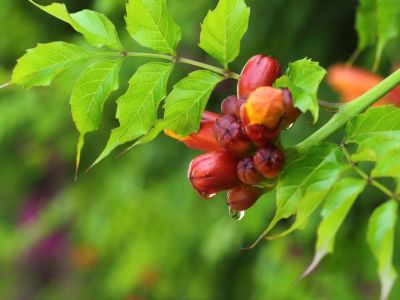Trumpet Vine Problems
Prolific blooms and wide ranging stems are characteristics of trumpet vine or Campsis radicans. This plant is such a tough specimen that it can thrive in USDA zones 4 to 10, quite a wide range of conditions for any plant. In fact, the creeper can become invasive in warm climates and is a plant of concern in higher temperature ranges. We have heard several readers commenting, “My trumpet vine is dropping buds.” What can be causing this? Since pests and disease are of little concern on this plant, the answers may be temperamental weather or boggy soil. This tough species has very little that can diminish its hearty, energetic growth. Vines can grow up to 35 feet (10.5 m.) in length, rooting with aerial roots and scrambling over anything in their path. The plant is native to eastern North America and has colonized regions to which it has been introduced. In the southeast, escaped plants have earned the names Hellvine and Devil’s Shoestring, indicators that the plant is a nuisance in those areas. Common issues might be the occasional leaf miner and powdery mildew. Both rarely diminish the vigor of the vines and health is minimally diminished. Trumpet vine is adapted to both wet and dry soils in cool to warm areas. Bud drop on trumpet vines planted in wet, shady locations may occur due to lack of sunlight.
My Trumpet Vine is Dropping Buds
The first thing to do is evaluate the plant’s health and its soil. Trumpet vines prefer a soil pH between 3.7 and 6.8. That is a pretty broad range and most areas can accommodate the plant, but a soil test might indicate your soil is too far one way or the other for best vine health. Most garden centers have these available and they are pretty easy to use. Lime will sweeten the soil and added sulfur will lower the soil pH. Add these amendments when the plant is not actively growing and you should see a difference come springtime. In spite of the plant’s ability to adapt to almost any soil, plants in boggy conditions will suffer. Amend soil with plenty of organic matter, fine sand, or even leaf clippings. If necessary, move the plant or build a drainage trench to allow moisture to run off. Enhanced health and energy to the plant may also decrease the occurrence of trumpet vine bud drop. Losing those buds reduces your flower display and minimizes the insects and birds that are attracted to the plant. Fertilize in late winter to early summer with a plant food low in nitrogen and slightly higher in phosphorus to encourage vital buds. Rejuvenation pruning may also be the answer. Tangled vines will benefit from cutting back and careful tying of stems to allow the buds access to light. Thin stems during the growing season and cut all the stems back to the ground in winter. New sprouts will be easier to manage, experience more air circulation and light, and can be trained for better exposure. The vine may also be experiencing stress due to an unnaturally cold winter with an early warm period followed by sustained freeze. Buds that form in an early warm up may drop off the vine if frozen for a long period. In most cases, this will correct itself later in the season.
